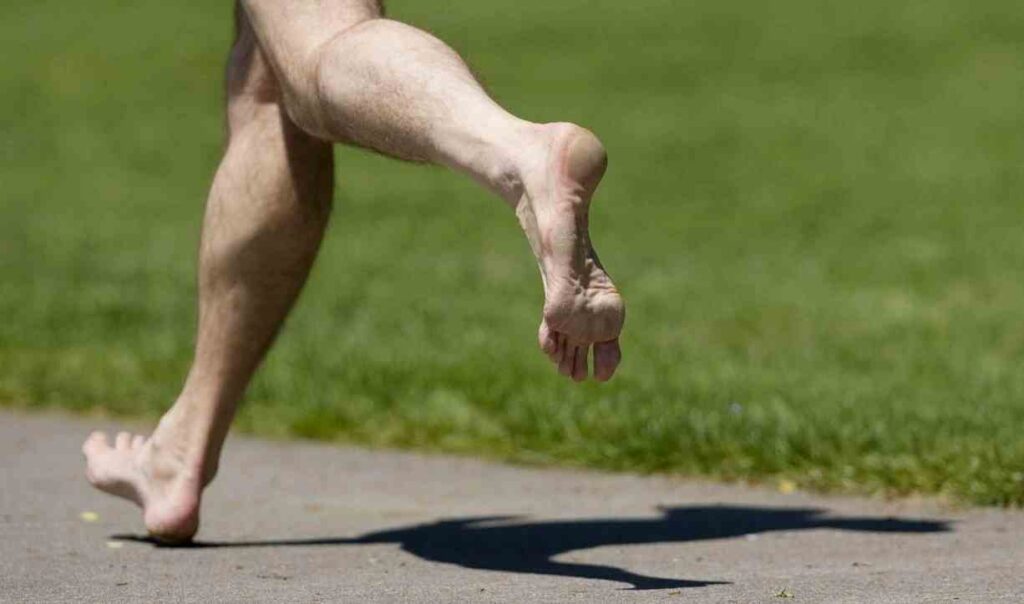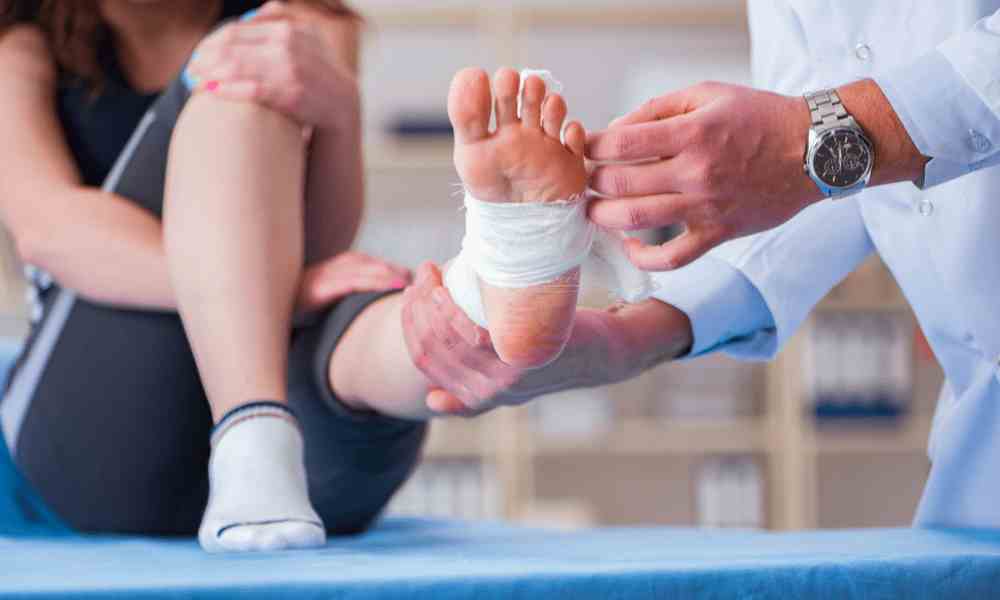Imagine hitting the pavement, grass, or trail without the familiar cushion of your running shoes. As your feet connect directly with the ground, you might feel a unique sense of freedom and natural movement. Barefoot running, once a niche practice, is gaining traction among runners and fitness enthusiasts. But what’s the real draw behind ditching your sneakers? Is it just a trend, or are there tangible benefits to running barefoot? Let’s uncover the surprising advantages that have barefoot runners raving and might just inspire you to kick off your shoes and join them.
The Science Behind Barefoot Running

The biomechanics of barefoot running differ from running with shoes in several key ways:
- Foot Strike Pattern: When running barefoot, individuals often adopt a forefoot or midfoot strike pattern, where the ball of the foot or the middle part of the foot makes initial contact with the ground. This contrasts with the heel strike pattern commonly associated with running in cushioned shoes.
- Reduced Impact Forces: Barefoot running encourages a shorter stride length and a quicker cadence compared to shod running. This can result in lower impact forces transmitted through the body, as the foot can better absorb shock and distribute forces more efficiently.
- Increased Foot Muscle Engagement: Running without shoes requires greater activation of the muscles in the feet, ankles, and lower legs to provide stability and propulsion. This can lead to stronger and more resilient foot muscles over time.
- Enhanced Sensory Feedback: Without the cushioning and support of shoes, barefoot runners receive more sensory feedback from the ground surface, including texture, temperature, and terrain variations. This heightened sensory input allows for better proprioception and kinesthetic awareness, enabling runners to adjust their stride and foot placement more dynamically.
- Improved Running Form: Barefoot running often promotes a more natural and efficient running gait, characterized by a slight forward lean, an upright posture, and a springy, elastic stride. By encouraging a midfoot or forefoot strike and a more even distribution of weight throughout the foot, barefoot running can help reduce overstriding and excessive braking forces, leading to smoother and more economical movement.
Scientific studies have analyzed these effects of barefoot running on the human body. For instance, Daniel Lieberman, a professor of human evolutionary biology at Harvard University, has conducted extensive research on the biomechanics of barefoot running. His work has shown the differences in impact forces and foot strike patterns between barefoot and shod runners. However, it’s important to note that there is no definitive evidence on whether running barefoot causes fewer or more injuries than running with shoes.
Another study found that barefoot running could contribute to changes in foot mechanics and motor performance. It was reported that running barefoot as compared with shod was associated with reduced ground reaction forces.
SHOP FOR THE BAREFOOT RUNNING SHOES ON AMAZON
While the science behind barefoot running is fascinating, it’s important to remember that transitioning to barefoot running should be a gradual process to avoid injury.
Benefits of Barefoot Running
Barefoot running, often considered as natural running, has several potential benefits. Here are some of them:
- Strengthening Foot Muscles: Running barefoot engages the muscles, tendons, and ligaments in your feet more actively than running with shoes. This can lead to stronger foot muscles and improved stability.
- Improved Balance and Proprioception: Without the cushioning and support of shoes, barefoot runners rely more on their proprioceptive feedback to adjust their movements. Over time, this can enhance balance and body awareness.
- Natural Biomechanics: Barefoot running often encourages a forefoot or midfoot strike pattern, which distributes impact forces more evenly throughout the foot and lower leg compared to the heel strike common in cushioned shoes. This can potentially reduce the risk of certain injuries.
- Reduced Impact on Joints: Some proponents of barefoot running argue that the reduced cushioning encourages a lighter, softer landing, which may decrease the impact on joints like the knees and hips.
- Enhanced Running Efficiency: By promoting a more natural running form and encouraging a shorter stride length, barefoot running may improve running efficiency and economy.
- Heightened Sensory Experience: Running barefoot allows you to directly feel the texture and temperature of the ground beneath you, providing a richer sensory experience that connects you more intimately with your environment.
- Potential Injury Prevention: While barefoot running comes with its own risks, such as cuts or abrasions, proponents argue that it can help strengthen the foot and lower leg muscles, potentially reducing the risk of certain overuse injuries.
- Mindfulness and Stress Reduction: Running barefoot requires a greater degree of focus and concentration, as you must be more aware of your surroundings and foot placement. This mindfulness can promote stress reduction and mental relaxation.
- Cost-Efficient: Unlike traditional running shoes, which can be expensive and require regular replacement, barefoot running requires no specialized equipment. This makes it a cost-effective option for many runners.
- Connection with Nature: Barefoot running allows you to feel more connected to the natural world around you, as you experience the ground beneath your feet in its rawest form. This can be a deeply rewarding and grounding experience for many runners.
- Improved Posture: Running barefoot often encourages a more upright posture, as it promotes a shorter stride length and engages the core muscles for stability. This can lead to better spinal alignment and reduced strain on the back.
- Increased Ankle Stability: Barefoot running requires greater ankle mobility and strength to adapt to uneven terrain and absorb impact forces. Over time, this can lead to increased ankle stability and reduced risk of ankle sprains.
- Enhanced Circulation: Running barefoot may improve blood circulation in the feet and lower legs by allowing the natural pumping action of the foot muscles to work more efficiently. This can potentially reduce the risk of conditions like peripheral artery disease.
- Better Running Form Awareness: Without the cushioning and support of shoes, barefoot runners are more attuned to their running form and mechanics. This heightened awareness can help identify and address biomechanical inefficiencies that may lead to injury.
- Potential for Rehabilitation: For some individuals with certain foot or ankle conditions, such as plantar fasciitis or Achilles tendonitis, barefoot running may serve as a rehabilitation tool. By strengthening the muscles and improving proprioception, barefoot running can help restore function and reduce pain.
Staying Active with a Desk Job
Remember, while there are potential benefits, barefoot running isn’t for everyone, and it’s important to transition slowly and safely if you’re interested in trying it out.
Transitioning to Barefoot Running
Transitioning from traditional running shoes to barefoot running is a process that should be approached gradually and with care. Here are some tips and techniques to help make the transition smoother:
Best Water Bottles for Workouts
- Start Slowly: Don’t rush into barefoot running. Start by walking barefoot more often, then slowly incorporate barefoot running into your routine. You could start with just a few minutes of barefoot running at a time.
- Listen to Your Body: Pay attention to how your body feels. If you experience pain or discomfort, it’s a sign that you may be pushing yourself too hard or too fast.
- Choose the Right Surface: Start on a soft, smooth surface like grass or a sandy beach. Avoid rough or rocky terrain in the beginning.
- Work on Your Form: Barefoot running often requires a different form than shod running. Focus on landing softly on the balls of your feet rather than your heels.
- Strengthen Your Feet: Barefoot running uses different muscles than shod running. Consider doing exercises to strengthen your feet and lower legs.
- Protect Your Feet: While the goal is to run barefoot, you may still need some protection. Consider investing in minimalist shoes or barefoot running shoes that provide some protection while still allowing for the natural movement of your feet.
- Be Patient: It takes time to adjust to barefoot running. Don’t be discouraged if progress is slower than you expected.
SHOP FOR THE BAREFOOT RUNNING SHOES ON AMAZON
By following these practical tips and prioritizing proper foot care, you can safely transition to barefoot running and reap the many benefits it has to offer.
Precautions and Potential Risks

Importance of Carbs After Exercise
While barefoot running can offer several benefits, it’s important to be aware of the potential risks:
- Risk of Foot Injuries: While barefoot running can strengthen the muscles and tendons in the feet, it can also increase the risk of certain injuries, particularly for those who transition too quickly or have underlying foot issues. Stress fractures, blisters, and cuts from sharp objects on the ground are all potential risks.
- Impact on Running Surfaces: Barefoot running may not be suitable for all types of surfaces. Rough or uneven terrain, hot pavement, and abrasive surfaces can increase the risk of injury. It’s important to choose running routes carefully and be aware of potential hazards.
- Transition Period: Transitioning to barefoot running requires patience and careful planning. Abruptly switching from traditional running shoes to barefoot running can put excessive strain on the feet and lead to injuries. Gradually increasing mileage and allowing time for the feet to adapt is essential for a safe transition.
- Impact on Running Form: Barefoot running often requires adjustments to running form and technique. Some individuals may experience discomfort or muscle soreness as they adapt to a new stride pattern and foot strike. Proper coaching or guidance from experienced barefoot runners can help minimize the risk of injury.
- Not Suitable for Everyone: Barefoot running may not be suitable for individuals with certain foot conditions, such as plantar fasciitis, bunions, or neuropathy. It’s important to consult with a healthcare professional before starting a barefoot running regimen, especially if you have pre-existing foot issues or medical concerns.
- Hygiene Considerations: Running barefoot exposes the feet to dirt, bacteria, and other environmental elements, which can increase the risk of infections or fungal growth. Proper foot hygiene, including washing the feet thoroughly after running and keeping toenails trimmed, is important for preventing foot-related issues.
- Weather Considerations: Extreme weather conditions, such as cold temperatures or icy surfaces, can pose additional challenges for barefoot runners. It’s essential to dress appropriately and take precautions to protect the feet from harsh environmental conditions.
FAQs
Q 1. What surfaces are best for starting barefoot running?
Ans. Ideal surfaces for beginners include soft, natural terrains like grass or sand, which provide a gentle introduction to barefoot sensations. Hard surfaces can also be beneficial as they encourage proper running form, but should be approached with caution and gradually.
Q 2. How does barefoot running impact knee and hip joints?
Ans. Barefoot running often leads to a forefoot or midfoot strike, which can reduce the impact on knee and hip joints compared to heel striking. This may result in fewer knee injuries and less heel pain, although it’s important to transition slowly to avoid overloading muscles and tendons.
Q 3. Can barefoot running help with posture?
Ans. Running barefoot can improve posture and balance as it encourages a more natural alignment of the body. The lack of cushioning and support in shoes allows for a more even distribution of pressure throughout the feet, which can contribute to better overall posture.
Q 4. What are the environmental considerations of barefoot running?
Ans. Environmental hazards such as rocks, glass, and extreme temperatures pose risks to barefoot runners. It’s important to choose clean, safe environments for barefoot running and to be mindful of potential injuries from the terrain.
Q 5. How does weather affect barefoot running?
Ans. Weather conditions can significantly impact barefoot running. Hot surfaces can burn the soles of the feet, while cold conditions can lead to decreased muscle strength and increased risk of injury. It’s crucial to adapt your barefoot running practices to the weather to prevent harm.
Q 6. How do I handle people’s reactions to barefoot running in public spaces?
Ans. Reactions to barefoot running in public can vary. It’s helpful to approach the situation with confidence and be prepared to explain the benefits if asked. Setting a positive example can encourage others to be more accepting of barefoot running.
Conclusion
In conclusion, barefoot running, a practice as old as humanity itself, offers a unique approach to running that promises numerous benefits, from improved balance and proprioception to stronger feet and lower legs. However, it’s not without its challenges and potential risks.
Transitioning to barefoot running requires patience, proper technique, and a gradual approach to avoid injury. It’s not for everyone, but for those willing to embrace it, barefoot running could be a step towards a more natural, connected, and enjoyable running experience. As always, consult with a healthcare or fitness professional before making any major changes to your exercise routines.

Good day, and welcome to Fitthour. My name is Shubham Vijay, and I am a certified personal trainer and nutrition coach with 6 years of experience in the fitness industry. At Fitthour, we specialize in types of training, such as strength training, cardio, or HIIT, and our mission is to help clients achieve their fitness goals and improve their overall health.



